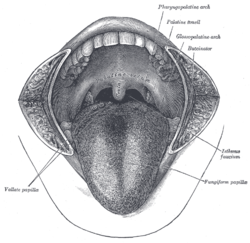This article needs additional citations for verification .(July 2019) |
| Fauces | |
|---|---|
 A view of the fauces through the mouth cavity. The cheeks have been slit transversely and the tongue pulled forward. (Fauces labelled as Isthmus faucium at center right.) | |
 Pharynx | |
| Details | |
| System | lymphoid system |
| Artery | faucial artery |
| Vein | faucial vein |
| Nerve | brachial plexus |
| Lymph | cervical nodes |
| Identifiers | |
| Latin | fauces |
| TA98 | A05.2.01.002 |
| TA2 | 2846 |
| FMA | 55006 |
| Anatomical terminology | |
The fauces (also termed the isthmus of fauces or oropharyngeal isthmus) is the opening at the back of the mouth into the throat. [1] It is a narrow passage between the velum and the base of the tongue. [2]
Contents
The fauces is a part of the oropharynx directly behind the oral cavity as a subdivision, bounded superiorly by the soft palate, laterally by the palatoglossal and palatopharyngeal arches, and inferiorly by the tongue. The arches form the pillars of the fauces (faucial pillars, tonsillar pillars, palatine arches). The anterior (front) pillar is the palatoglossal arch formed of the palatoglossus muscle. The posterior (back) pillar is the palatopharyngeal arch formed of the palatopharyngeus muscle. Between these two arches on the lateral walls of the oropharynx is the tonsillar fossa which is the location of the palatine tonsil. [3]
Each arch runs downwards, laterally and forwards, from the soft palate to the side of the tongue. The approximation of the arches due to the contraction of the palatoglossal muscles constricts the fauces, and is essential to swallowing.
